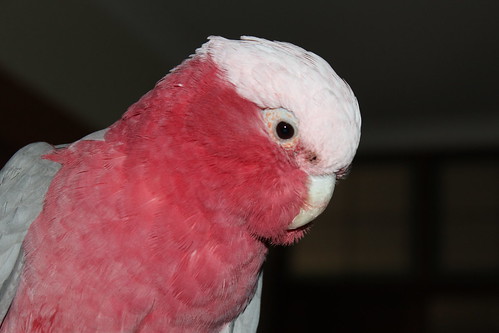
Charlie the galah. His previous owner took him to the vet to get his darkened nostrils checked out but no cause was found. We now know that Charlie’s liver was causing vomiting that was mild enough not to be noticed. A discharge from his nostrils were a part of that.
I’ve found myself in the worst place to be when it comes to developing a healthy relationship with a bird. My Galah, Charlie, came to me from a decent home but had a rescue history prior to his last home which has left him prone to serious trust issues. Medicating a bird is difficult at the best of times, but when trust is already an issue it can be a real nightmare. This comes before I’ve had a chance to do anything to earn his trust to help offset the current situation. What’s worse? His condition is permanent. I can’t wait for the medication period to end because it simply won’t. This sounds easy to get through, doesn’t it?
If someone else asking for help presented the above situation to me, I know what I’d suggest to do. I’d advise the person to start some trick training. I’d say build some trust by positive encounters and trick training (if done correctly) could be fun for both human and bird, it’s an excellent way of building communication and trust. That way not every encounter is going to be about medication and you have some chance of developing a decent relationship.

Love at first sight! Charlie very quickly decided mum is the world’s most wonderful person. Unfortunately, this makes it difficult for anyone else to handle him.
Well, apparently I can’t actually follow my own advice. Training works better when your bird is on a training diet. A bird with an ongoing health problem can’t always be put on a training diet. In my Galah Charlie’s case, due to the way his enlarged liver has pressed his digestive system out of place he tends to graze, eating small amounts consistently throughout the day. He doesn’t do well with set meals. If I try to implement “meals” I end up with a very sick, vomiting bird. So the idea of catching him before a meal when he’s motivated to train? Well it just doesn’t happen.
So that’s ok, training is still possible. I should just restrict his favourite foods to training sessions, right? I won’t be able to catch him before he eats but his desire for the “better” food might help. Well, I can’t do that either. What sort of food training reward could I possibly give to a bird that is on such a strict diet? No seed. No nuts. None of the traditional rewards are allowed.
As if all of the above isn’t bad enough, I have another problem that has arisen directly because of the fact that I’m medicating Charlie daily and have had to do other bits and pieces to him in order to save his life. I am the syringe-wielding troll. My mother? Charlie adores her. The sun apparently glows in a rosy halo around her head. I’m living with the dreaded thing known as a “one-person bird” and I’m not the lucky one person. The syringe-wielding troll is the one who gets bit. My mother gets cuddles.
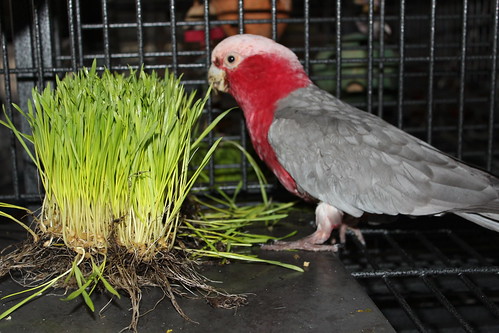
What a “treat” is nowadays for Charlie. Wheat Grass can be a lot of fun, but it isn’t easy to use it as a training reward.
Well this is a common problem in my situation but wait there is good news! There’s an answer I usually point people to for the “one-person bird” problem too. Have you heard of the 60:40 rule? (Click here for a post on that.) I’m going to quote Patty (another Birdtricks blogger) here:
“The 60:40 rule refers to the ratio of acceptance you want your bird to have. A bird will almost always have a preference for one person so you strive for getting the bird to give you 40% if you are not the preferred person. Sometimes you arrive at that ratio by dividing up the work and interaction but the ratio is about how the bird regards the people. We then make decisions based on that ratio such as if you are the bird’s 60 person then you should be the one that initially trains recall etc.”
At the moment Charlie likes mum a lot more than me (90:10), which is making it difficult for me to do anything with him. In theory, because she is preferred she should be able to get away with giving him medication without damaging the relationship too much but it just isn’t happening – she won’t do it. I need to spend more time than mum does with Charlie to counteract not being the preferred human. However, if mum is around he goes straight to her and even if she isn’t, he goes straight to her armchair and wants to wait for her to show up. I’m fighting to even get a few seconds of his attention. Somehow I need to find a way to spend more time with Charlie and not just doing the bad stuff when I am with him.
Firstly, and rather bluntly, mum’s too soft. She gets very upset when she sees a bird distressed at the sight of a syringe. She doesn’t acknowledge that the bird is picking up on her emotional state as much as anything else. If I do it – it’s over fast before things can go wrong. If mum tried it she’d be too scared, too worried about hurting him, to even begin to try to hold him in a firm grip and he’d take full advantage of that. He’d squirm, cry, bite, break free, his movement would make the meds go down the wrong way and I’m left fixing an aspirating, choking bird. (No offense mum. Love you dearly but you suck at dealing with sick animals.)
The second problem with the above is my mum loves being the one person Charlie adores, so she is actively encouraging him to spend all of his out of cage time with her. The 60:40 rule is only going to work if you have the cooperation of the person the bird adores. If the other person won’t cut back enough to let you put in the work to fix the balance – you really are in trouble. This is made worse by the fact that my mother has absolutely no interest in doing what she sees as the un-fun stuff related to living with birds. She will do it if she has to, but it’s reluctantly and she won’t be enough to counteract the negative impact of the amount I have to do. I’m on my own with this problem. I’ve heard many people who aren’t the favourite person with other birds; say they can’t get the favourite human to cooperate either.
Got a headache from my list of problems yet? Don’t worry I’m about to make it go away.
I’ve got some good news for people in this situation and this time it’s genuine good news. There is a way to fix the above without the uncooperative human even knowing they’re helping you to fix it. In fact, the less cooperative they are, the more they accept being the favourite human – the better.
The answer can be found within my list of problems. What can you use for a treat for a bird that isn’t allowed seeds, nuts or really any food reward? I asked. Well it turns out Charlie wants something more than a food reward. Meet my mum:
Yup, you got it folks. My mother is now officially a nut and she doesn’t even know it.
When I appear with a syringe, all Charlie wants, is to get to mum because her shoulder is where no syringe will ever venture. So for those of you facing these sorts of trust issues but who don’t have the one-person to turn into a nut, your nut might well be a favourite perch or another bird that your sick bird feels safe with. The trick is to work out what your bird wants and to start to see it as a reward.
So the bird doesn’t want to be with you, but wants to be with its reward? The trick is to work this situation so that the bird gets to be with it’s chosen person/reward as a reward only as a result of some sort of interaction with you.
So slipping back to my Charlie situation. I have sneakily started getting Charlie out of his cage before my mother could have a chance to do so. The first few times, both Charlie and my mother thought what I was doing was accidentally letting him escape his cage and get to her. Except it wasn’t an accident, I was actually being very manipulative. I knew that if Charlie got to mum, she’d cuddle and play with him, but wouldn’t get him out of his cage later because from her perspective she had already done that. Suddenly, without either Charlie or my mother even noticing that I was running training sessions – I became the person in control of whether or not Charlie got to mum. After a few “accidental” releases, Charlie began to look at me as his way to mum. Meanwhile mum learned that she didn’t have to get out of her armchair to get her bird, so she started asking me to get him for her. I no longer had to pretend it was an accident and was still secretly training them both.
So how did this work? At the start of this process, any time that I would approach Charlie’s cage he’d freak out. He was terrified I was going to towel and medicate him. He was frantically trying to get away from me and get to my mother. He’d flap around his cage (seriously risking injuring himself), bite me if he got a chance and even fly at my face if he so much as glimpsed a way past me. I used this. I would intentionally open the door enough so he could fly at my face, I’d duck, he’d get past and I’d say: “Whoops” and both mum and Charlie would think that Charlie won that round.
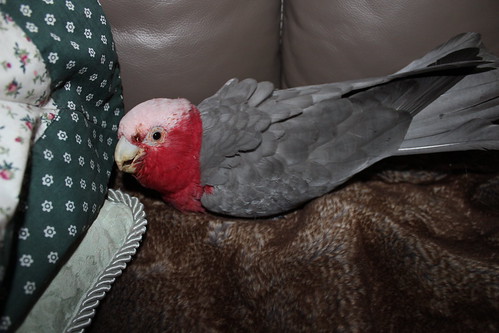
Charlie’s favourite spot. Nothing about this body language promises cooperation. Good luck getting him to step up! He says he’s sleeping right there.
The next part is important. Once he “escaped” I could not chase him or do anything that might create any sort of punishment. I wanted him to be happy that he got out and got to mum – the stronger the reward the better. Mum meanwhile, was delighted that a bird would choose her instead of me and fussed over him accordingly. Technically that sort of response from her was only going to make the one-person bird bond stronger. I wasn’t worried about that though.
After a few “Whoops” episodes, Charlie was less panicked when I approached his cage. He became more confident in his ability to get past me. So much so that he’d stop wasting time flapping around his cage and instead go straight to trying to fly past any visible gap by my head. He’d found an escape technique that worked and confidently tried to use it.
The problem was that I still had to medicate Charlie during this process. He’d try the same technique whenever I had a syringe ready to go. What Charlie couldn’t possibly know is that when he “escapes” it’s on purpose. If the training was to work, he needed to see a reason why his “escape” didn’t work for the scary medication sessions. He began to blame the towel. If I had a towel with me – he’d get medicated, if I didn’t, he could get past me. A hatred of towels is a lot easier to deal with compared to a bird that is terrified of you coming near it!
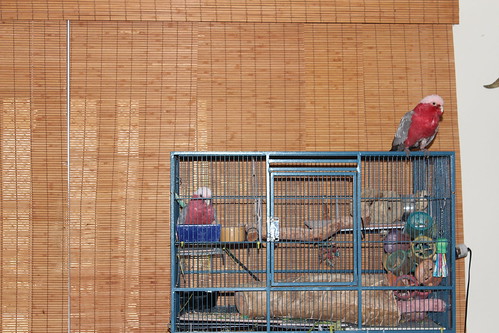
Charlie and my elderly disabled galah Cocky Boy have become good friends. Handy because it doesn’t hurt Charlie to see another bird take medication quite happily!
Once Charlie understood that all he had to do was look for a gap over my right shoulder and fly through it to get to mum, I had the basis to begin training him. I began to intentionally to block his cage door with my body carefully leaving no gap, for a few seconds each time I approached him. Similar to the power pause method, I’d wait until his posture relaxed just a fraction and then I’d let the gap appear allowing his “escape”. Gradually I was able to build up the time before he’d escape.
There is a definite similarity with what I was doing to the “power pause” method. (Click here to see the “power pause” video). “Power Pause” is what we recommend to people who have a bird that is not ready for training yet. In other words, during those early stages when the sight of you freaks out your bird and it won’t take a treat or reward from you yet. The “Power pause” technique is fine for a normal bird but it isn’t always going to work on a severely abused bird, or bird that is currently receiving medication.
In my situation, the medication sessions unfortunately maintain my status as a negative stimulus to Charlie. I can try the “power pause” technique as much as I want, but I undo any trust that I earn twice a day when I have to produce that syringe. So I needed extra motivation to help Charlie see me as something other than a syringe-wielding troll. Which is why I found myself needing two types of reinforcement in order to increase Charlie’s motivation to be around me. The negative reinforcement is removing the negative stimuli from the bird (i.e. let him get away from me), combined with positive reinforcement (the reward of getting to mum).
So over the last few weeks, I’ve gradually been increasing the interaction I’ve been having with Charlie before I let him get to mum. Once he stopped panicking, I was able to even offer him my hand to step up on. (I’m lucky he’s had step up training from his previous owner.) At the start, he’d just scramble up my arm and take off from my shoulder to get to mum. Slowly though, the scramble has slowed. After a few weeks of this, he is now slowly climbing up onto my shoulder, talking to me as he’s doing it. He allows me to kiss him on the head and carry him to mum, instead of him having to panic and fly. I’m gradually managing to increase the amount of time he’ll spend with me.
Gradually I am losing my status as a negative stimulus. This is also having a significant impact on my “one person bird” problems. I suspect mum is always going to be Charlie’s favourite and that’s fine. The more trust I build by doing the above, the more I am now able to interact with him without getting bit though. Which is a really great result considering that the preferred human doesn’t want to train or medicate the bird!
Obviously, the more the above works, the less the reinforcement I’m using is going to work long term. If I’m no longer a negative stimulus, getting away from me is no longer reinforcing. If mum is no longer the only person on the planet Charlie wants to be with, her value as a reward for positive reinforcement diminishes too.
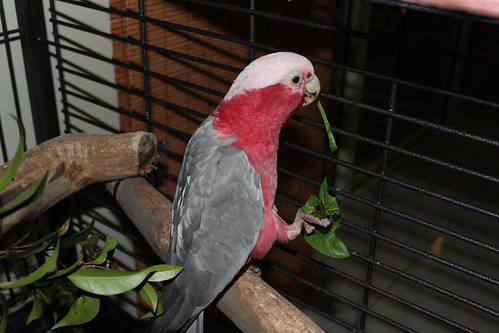
Turns out that Charlie LOVES spinach! Especially if it was only picked a minute or so ago. (I grow my own.)
All is not lost however. I have lorikeets. They have trained me well in methods of rewarding birds that don’t eat seeds and nuts! (Click here for a blogpost on difficult to reward birds.) I should in theory, soon be able to move onto some normal training with Charlie using those sorts of rewards instead of the normal food rewards that we associate with training.
The other thing that’s going to come up? Charlie’s fear of towels. I’ve found that allowing him to develop a fear of towels has helped speed things up. I wanted to develop some sort of trust with Charlie and I wanted to do it FAST in order to make the medication sessions less stressful to him. So allowing him to blame the towel for his failure to escape me at medication times, has been handy but it isn’t great long term. If a vet ever needs to towel him… I don’t want him to freak out.
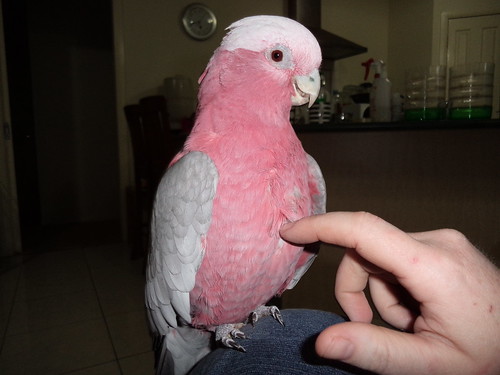
One of my other galahs, this is Morgy. As you can see, she happily climbs into my lap and actually asks for her medication. (Possibly it helps that I have them made so that they’re honey flavoured?)
Fortunately, I don’t have to towel my other galahs that have permanent conditions when I medicate them. The more practice you have with a syringe – the easier it gets. As I build trust with Charlie, I plan to stop using a towel completely and medicate him in the same way that I medicate the others. They barely even seem to notice when I produce a syringe – it’s just one more quick interaction. By then, I plan to have done enough training with Charlie to be able to do something to reduce Charlie’s fear of towels. (Click here for a post about how I worked to reduce my Eclectus parrot’s fear of wall hangings.)
It’s complicated I guess and no doubt other bits and pieces are going to come up – but it’s worth putting in the effort. Oh and mum has noticed. “It’s weird how Charlie likes you now, isn’t it?” she said the other day. I did think about telling her why, but then it occurred to me that she might start yelling if she notices that I smile whenever I see a walnut.
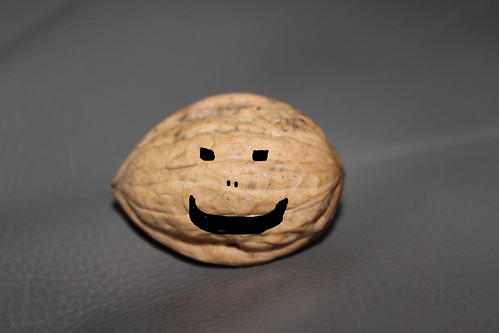
Mel Vincent works as an animal rehabilitator out of Australia.



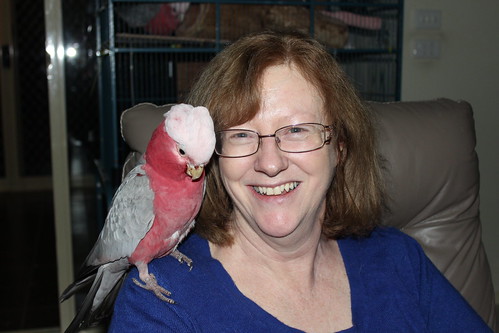
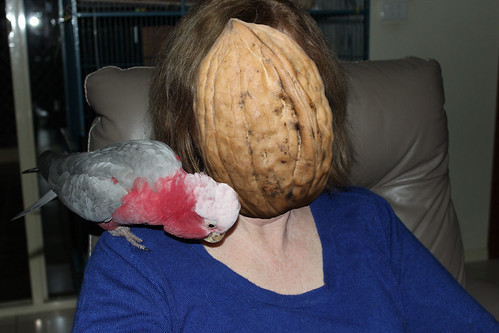
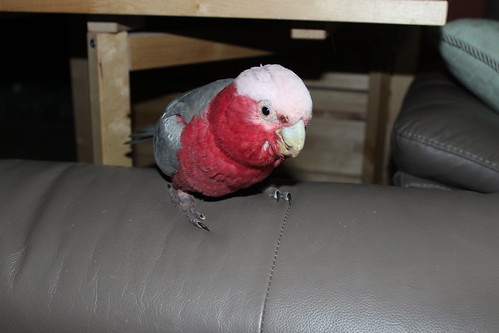

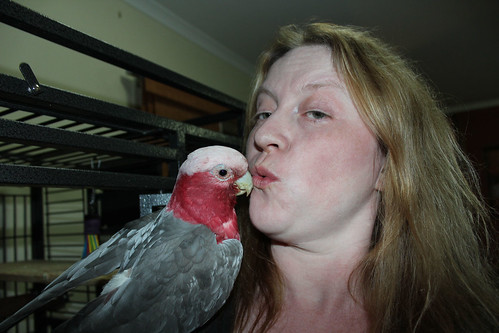
2 comments
Hi Mel, I read your blogs regularly. Thank you for sharing you knowledge. I have a Male Galah who has the same dark colour pink and the same nasal discharge, the bird vet I went to didn’t know what it was, perhaps a result of an allergy he thought , but you say it is a result of vomiting? Makes sense. He is painfully thin (Keel sticks out ) and strips his belly and back feathers (I have had him 2 years and he was given to me this way, hes about 22 now) I have long suspected him of liver disease but cannot afford the avian vet who lives 2 hours away. He’s always very lively and affectionate (except in spring when he is a terrifying monster to his mate and me and has to be separated for months) He is a seed addict but I also give him lots of daily veges and am trying (unsuccessfully) to wean him onto some sample Roudybush Pellets now (I live in NZ). Any advice on diet would be appreciated, He is stubbonly addicted to seed despite me trying all the Birdtricks cookbook recipies. He fades away almost to nothing without millet to top up his veges etc. Getting a bit desperate to help him. Thanks
Rubbish! If your Mum won’t help with the unfun stuff, she obviously has no respect for you or the birds you love so much. She should pull her bloody finger out and give you the help and support you need instead of reinforcing Charlie’s issues. Why should you have to work so hard?
Leave a comment